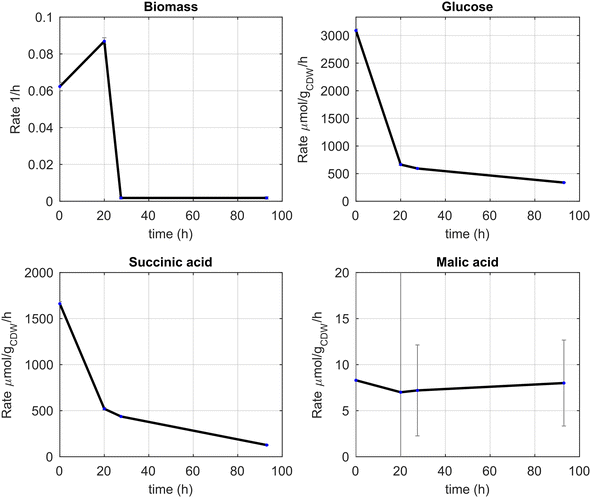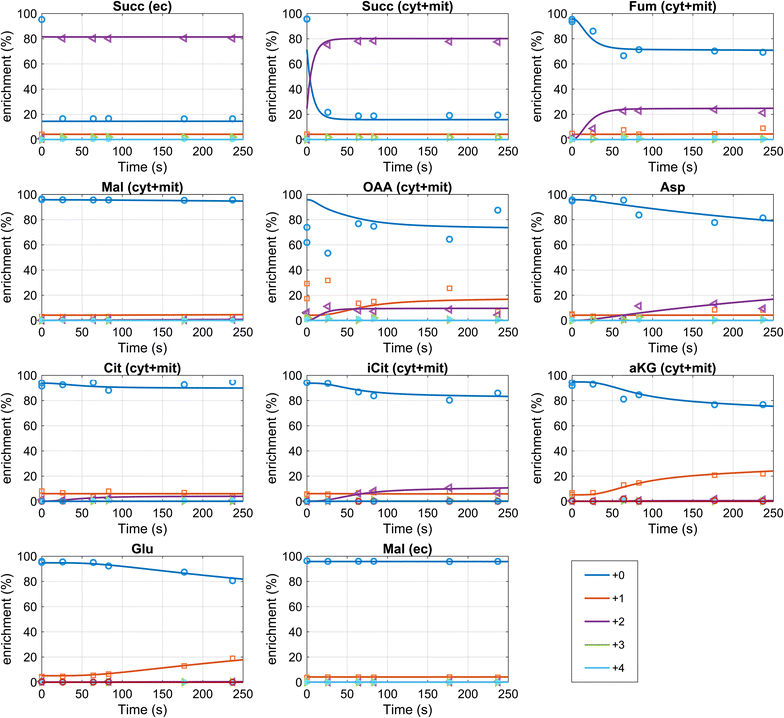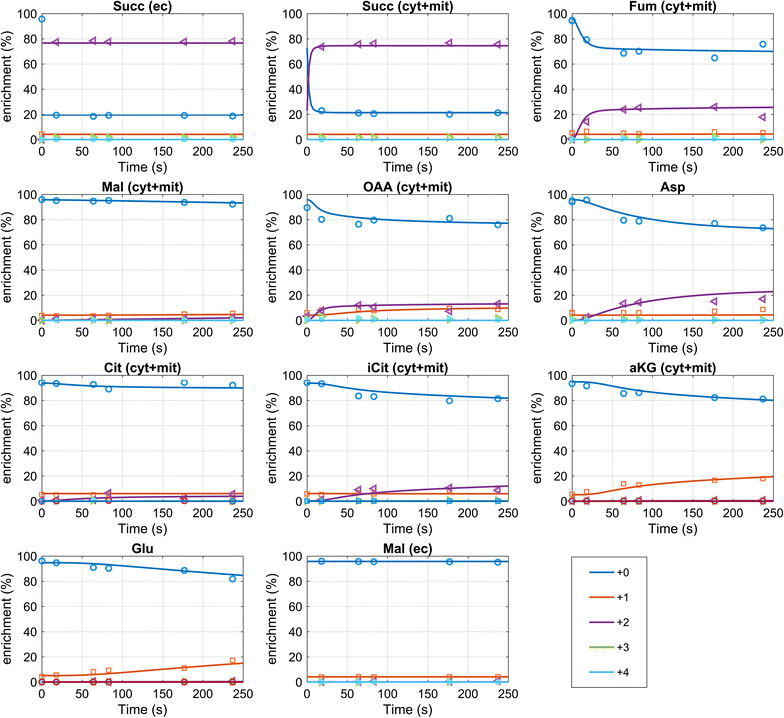Intracellular product recycling in high succinic acid producing yeast at low pH
- PMID: 28535757
- PMCID: PMC5442661
- DOI: 10.1186/s12934-017-0702-0
Intracellular product recycling in high succinic acid producing yeast at low pH
Abstract
Background: The metabolic engineering of Saccharomyces cerevisiae for the production of succinic acid has progressed dramatically, and a series of high-producing hosts are available. At low cultivation pH and high titers, the product transport can become bidirectional, i.e. the acid is reentering the cell and is again exported or even catabolized. Here, a quantitative approach for the identification of product recycling fluxes is developed.
Results: The metabolic flux distributions at two time-points of the fermentation process were analyzed. 13C labeled succinic acid was added to the extracellular space and intracellular enrichments were measured and subsequently used for the estimation of metabolic fluxes. The labeling was introduced by a labeling switch experiment, leading to an immediate labeling of about 85% of the acid while keeping the total acid concentration constant. Within 100 s significant labeling enrichment of the TCA cycle intermediates fumarate, iso-citrate and α-ketoglutarate was observed, while no labeling was detected for malate and citrate. These findings suggest that succinic acid is rapidly exchanged over the cellular membrane and enters the oxidative TCA cycle. Remarkably, in the oxidative direction malate 13C enrichment was not detected, indicating that there is no flux going through this metabolite pool. Using flux modeling and thermodynamic assumptions on compartmentation it was concluded that malate must be predominantly cytosolic while fumarate and iso-citrate were more dominant in the mitochondria.
Conclusions: Adding labeled product without changing the extracellular environment allowed to quantify intracellular metabolic fluxes under high producing conditions and identify product degradation cycles. In the specific case of succinic acid production, compartmentation was found to play a major role, i.e. the presence of metabolic activity in two different cellular compartments lead to intracellular product degradation reducing the yield. We also observed that the flux from glucose to succinic acid branches at two points in metabolism: (1) At the level of pyruvate, and (2) at cytosolic malate which was not expected.
Keywords: 13C labeling; Metabolic flux analysis; Saccharomyces cerevisiae; Succinic acid production.
Figures







Similar articles
-
Transport and metabolism of fumaric acid in Saccharomyces cerevisiae in aerobic glucose-limited chemostat culture.Yeast. 2016 Apr;33(4):145-61. doi: 10.1002/yea.3148. Epub 2016 Feb 15. Yeast. 2016. PMID: 26683700
-
Alpha-ketoglutarate utilization in Saccharomyces cerevisiae: transport, compartmentation and catabolism.Sci Rep. 2020 Jul 30;10(1):12838. doi: 10.1038/s41598-020-69178-6. Sci Rep. 2020. PMID: 32733060 Free PMC article.
-
Construction of reductive pathway in Saccharomyces cerevisiae for effective succinic acid fermentation at low pH value.Bioresour Technol. 2014 Mar;156:232-9. doi: 10.1016/j.biortech.2014.01.053. Epub 2014 Jan 24. Bioresour Technol. 2014. PMID: 24508660
-
[Advances in synthesis of succinic acid using yeast cell factories].Sheng Wu Gong Cheng Xue Bao. 2024 Aug 25;40(8):2644-2665. doi: 10.13345/j.cjb.240349. Sheng Wu Gong Cheng Xue Bao. 2024. PMID: 39174474 Review. Chinese.
-
Metabolic Engineering of TCA Cycle for Production of Chemicals.Trends Biotechnol. 2016 Mar;34(3):191-197. doi: 10.1016/j.tibtech.2015.11.002. Epub 2015 Dec 17. Trends Biotechnol. 2016. PMID: 26702790 Review.
Cited by
-
Metabolomics analysis of gut barrier dysfunction in a trauma-hemorrhagic shock rat model.Biosci Rep. 2019 Jan 8;39(1):BSR20181215. doi: 10.1042/BSR20181215. Print 2019 Jan 31. Biosci Rep. 2019. PMID: 30393232 Free PMC article.
-
Uncoupling growth and succinic acid production in an industrial Saccharomyces cerevisiae strain.Biotechnol Bioeng. 2021 Apr;118(4):1576-1586. doi: 10.1002/bit.27672. Epub 2021 Jan 21. Biotechnol Bioeng. 2021. PMID: 33410171 Free PMC article.
-
Physiological responses of Saccharomyces cerevisiae to industrially relevant conditions: Slow growth, low pH, and high CO2 levels.Biotechnol Bioeng. 2020 Mar;117(3):721-735. doi: 10.1002/bit.27210. Epub 2020 Jan 22. Biotechnol Bioeng. 2020. PMID: 31654410 Free PMC article.
-
Metabolic adjustment upon repetitive substrate perturbations using dynamic 13C-tracing in yeast.Microb Cell Fact. 2017 Sep 25;16(1):161. doi: 10.1186/s12934-017-0778-6. Microb Cell Fact. 2017. PMID: 28946905 Free PMC article.
-
Integrated Metabolomics and Proteomics Analysis of the Myocardium in a Mouse Model of Acute Viral Myocarditis.Immun Inflamm Dis. 2025 Feb;13(2):e70151. doi: 10.1002/iid3.70151. Immun Inflamm Dis. 2025. PMID: 39912544 Free PMC article.
References
-
- van Maris AJ, Geertman JM, Vermeulen A, Groothuizen MK, Winkler AA, Piper MD, van Dijken JP, Pronk JT. Directed evolution of pyruvate decarboxylase-negative Saccharomyces cerevisiae, yielding a C2-independent, glucose-tolerant, and pyruvate-hyperproducing yeast. Appl Environ Microbiol. 2004;70:159–166. doi: 10.1128/AEM.70.1.159-166.2004. - DOI - PMC - PubMed
MeSH terms
Substances
LinkOut - more resources
Full Text Sources
Other Literature Sources
Molecular Biology Databases

